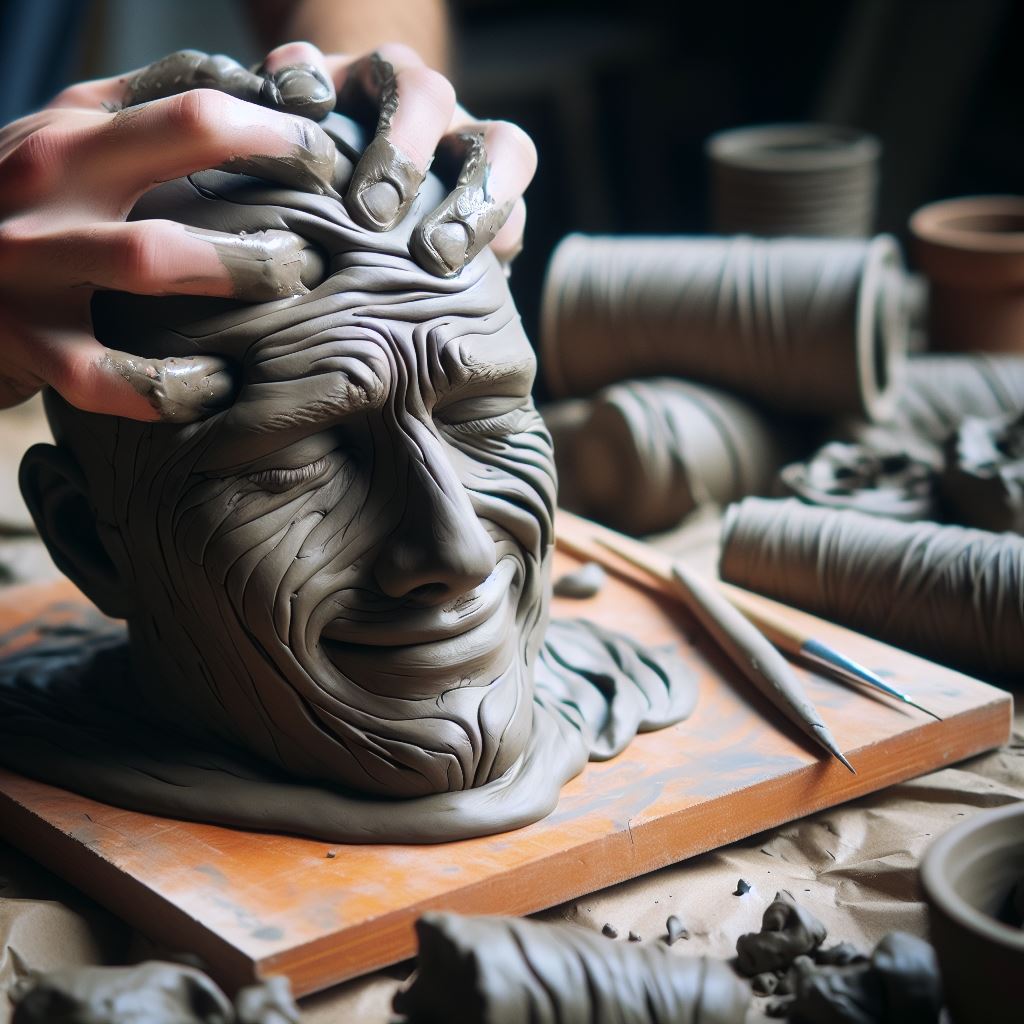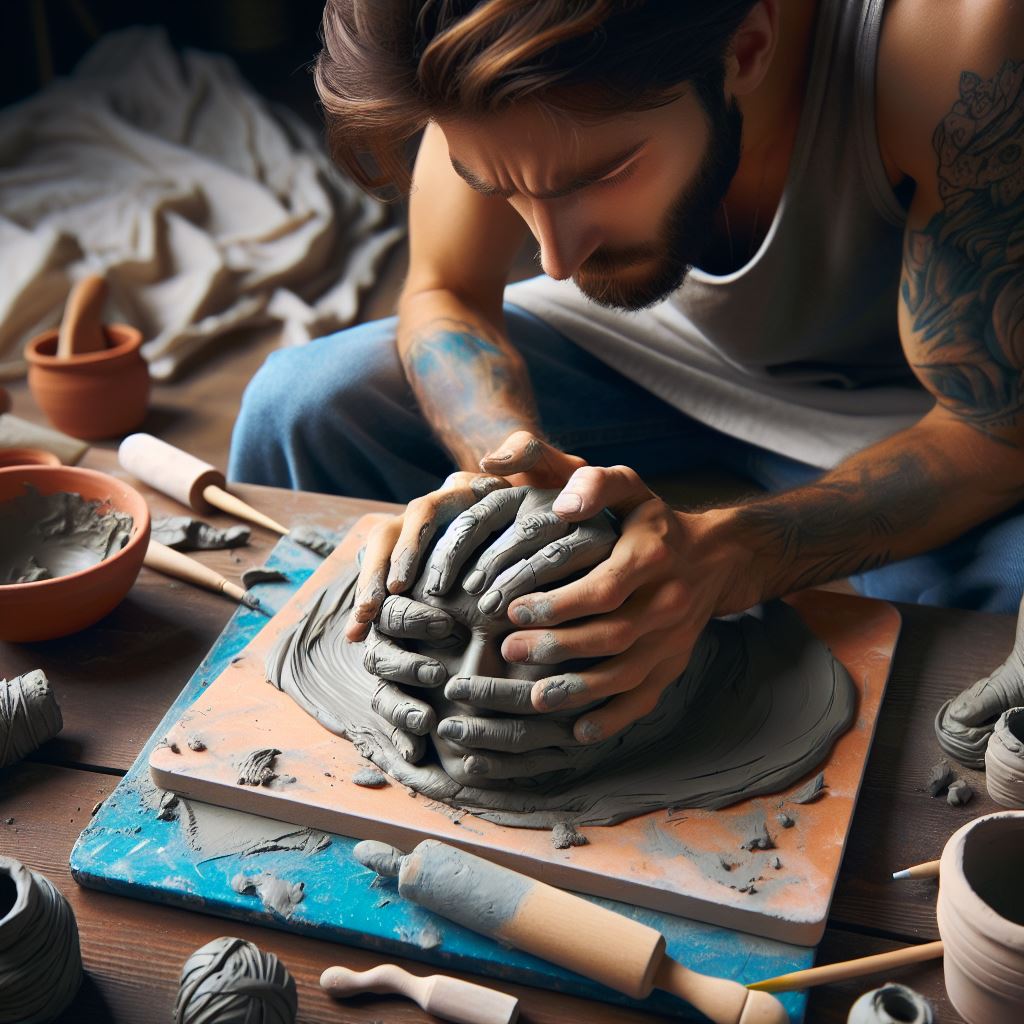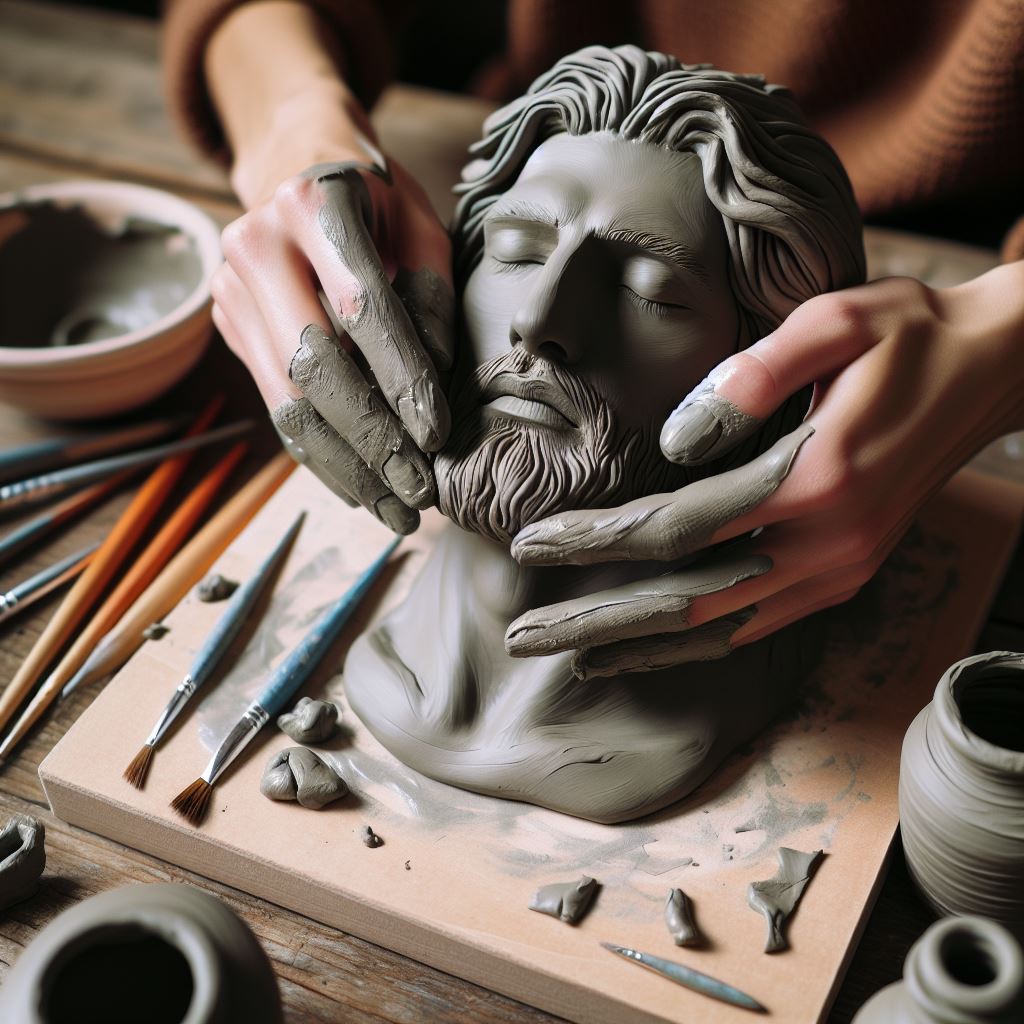Table Of Contents
- 1 Sculpting with Clay: A Therapeutic Haven for Stress Relief and Anxiety
- 1.1 Understanding the Physiology of Stress and Anxiety:
- 1.2 Clay Sculpting as a Therapeutic Intervention:
- 1.3 Unveiling the Science Behind Clay Sculpting’s Therapeutic Magic
- 1.4 1. The Neurochemistry of Stress and Anxiety:
- 1.5 2. Clay Sculpting’s Impact on Neurochemistry:
- 1.6 3. The Mind-Body Connection:
- 1.7 A Practical Guide to Therapeutic Intervention for Stress and Anxiety
- 1.8 Embark on Your Therapeutic Clay Sculpting Journey:
- 1.9 Clay Sculpting Exercises for Stress Relief and Anxiety:
- 1.10 The Transformative Power of Clay Sculpting:
- 1.11 FAQs:
- 1.12 Conclusion:
Sculpting with Clay: A Therapeutic Haven for Stress Relief and Anxiety

In the hustle and bustle of modern life, stress and anxiety have become pervasive elements of our daily experiences. These mental burdens often manifest in physical and emotional distress, impacting our overall well-being. Amidst the chaos, clay sculpting emerges as a therapeutic haven, offering a unique and effective means of stress relief and anxiety management.
The therapeutic benefits of clay sculpting extend beyond mere relaxation. It provides an avenue for self-expression, allowing individuals to channel their emotions and experiences into tangible creations. As they mold and shape the clay, individuals engage in a meditative practice, fostering mindfulness, focus, and a sense of calm.
Understanding the Physiology of Stress and Anxiety:
To fully appreciate the therapeutic value of clay sculpting, it’s essential to understand the underlying mechanisms of stress and anxiety. Stress, a natural response to perceived threats, triggers a cascade of physiological changes. The body releases stress hormones, such as cortisol, which prepare us for a “fight-or-flight” response.
When stress becomes chronic, this stress hormone response can lead to a range of physical and emotional symptoms, including:
-
Increased heart rate and blood pressure
-
Muscle tension
-
Difficulty sleeping
-
Irritability and mood swings
-
Fatigue
-
Difficulty concentrating
Anxiety, a persistent state of worry and apprehension, shares many of the same physiological symptoms as stress. However, it is characterized by an excessive and irrational fear response, often in the absence of a clear threat.
Clay Sculpting as a Therapeutic Intervention:

Clay sculpting offers a holistic approach to combating stress and anxiety by addressing both the physical and mental aspects of these conditions.
1. Physical Relaxation:
The repetitive and tactile nature of clay sculpting promotes physical relaxation by releasing tension in the muscles and joints. Kneading, rolling, and shaping the clay provide a gentle massage-like effect, easing muscle tension and promoting relaxation throughout the body.
2. Emotional Processing and Self-Expression:
Clay sculpting serves as a powerful tool for emotional expression, allowing individuals to channel their feelings and experiences into tangible forms. The process of shaping the clay provides a non-verbal outlet for emotions, facilitating self-awareness and emotional processing.
3. Mindfulness and Focus:
The focused and mindful engagement required for clay sculpting promotes relaxation and stress reduction by drawing attention to the present moment. As individuals concentrate on the task at hand, worries and anxieties fade into the background, fostering a sense of calm and clarity.
4. Creative Fulfillment and Sense of Accomplishment:
Clay sculpting provides an avenue for creative expression, allowing individuals to explore their artistic potential and derive a sense of accomplishment from their creations. The completion of a clay sculpture instills a sense of pride and satisfaction, boosting self-esteem and confidence.
5. Sensory Engagement and Tactile Stimulation:
The tactile nature of clay sculpting provides a rich sensory experience, engaging the sense of touch and promoting relaxation. The smooth, pliable texture of the clay soothes the senses, while the process of shaping and molding the clay provides a sense of grounding and connection to the present moment.
Unveiling the Science Behind Clay Sculpting’s Therapeutic Magic
Clay sculpting, an ancient art form, has transcended its creative roots to become a recognized therapeutic modality. Its therapeutic benefits are not merely anecdotal but grounded in scientific understanding of the mind-body connection. Let’s explore the science behind clay sculpting’s magic, unraveling its profound impact on stress reduction, anxiety management, and emotional well-being.
1. The Neurochemistry of Stress and Anxiety:
The human brain is an intricate network of neurons, neurotransmitters, and hormones that orchestrate our thoughts, emotions, and behaviors. When we experience stress or anxiety, a cascade of neurochemical changes occurs.
-
Stress Response: When we perceive a threat, the brain triggers the release of stress hormones, such as cortisol and adrenaline. These hormones prepare the body for a “fight-or-flight” response, increasing heart rate, blood pressure, and muscle tension.
-
Anxiety Response: Anxiety, characterized by persistent worry and apprehension, is often associated with an overactive amygdala, the brain’s emotional center. This overactivity leads to a heightened sensitivity to potential threats, perpetuating the cycle of anxiety.
2. Clay Sculpting’s Impact on Neurochemistry:
Clay sculpting, by engaging the mind and body in a holistic manner, counteracts the negative effects of stress and anxiety on the brain’s neurochemistry.
-
Stress Response Mitigation: The calming and relaxing nature of clay sculpting helps regulate the stress hormone response. As individuals focus on the tactile experience of molding and shaping the clay, stress hormones gradually decrease, promoting relaxation and a sense of calm.
-
Anxiety Reduction: Clay sculpting provides an outlet for emotional expression, allowing individuals to process and release pent-up anxiety. By channeling emotions into tangible creations, the amygdala’s overactivity is reduced, easing anxiety symptoms.
-
Endorphin Release: The therapeutic process of clay sculpting triggers the release of endorphins, the body’s natural painkillers and mood elevators. Endorphins promote feelings of well-being, reducing stress perception and enhancing relaxation.
3. The Mind-Body Connection:
Clay sculpting’s therapeutic effects extend beyond neurochemistry, deeply impacting the mind-body connection.
-
Mindfulness and Focus: Clay sculpting requires focused attention and concentration on the present moment. This mindful engagement helps individuals detach from stressful thoughts and anxieties, promoting relaxation and mental clarity.
-
Sensory Integration: The tactile and sensory nature of clay sculpting engages multiple sensory pathways, promoting sensory integration. This integration helps ground individuals in the present moment, reducing stress and anxiety.
-
Self-Expression and Emotional Processing: Clay sculpting provides a non-verbal means of self-expression, allowing individuals to channel their emotions into tangible forms. This emotional processing facilitates self-awareness and emotional healing.
A Practical Guide to Therapeutic Intervention for Stress and Anxiety

Clay sculpting, a versatile art form, has emerged as a powerful therapeutic intervention for stress relief and anxiety management. By engaging the mind and body in a holistic manner, clay sculpting promotes relaxation, mindfulness, and emotional expression, fostering overall well-being.
Embark on Your Therapeutic Clay Sculpting Journey:
To fully harness the therapeutic benefits of clay sculpting, consider these practical tips and techniques:
1. Choose a Suitable Clay:
Opt for air-dry clay for beginners, as it requires no firing and is easy to use. Polymer clay offers greater versatility and durability, but requires baking. Earthenware, stoneware, and porcelain clays demand kiln firing for hardening.
2. Gather Essential Tools:
Equip yourself with basic tools like pottery wheels (for symmetrical forms), sculpting knives, clay ribbons, rolling pins, sponges, and a sculpting tools set for intricate details.
3. Prepare Your Clay:
Knead the clay thoroughly to remove air bubbles, distribute moisture evenly, and make it soft and pliable. Roll the clay to create even sheets and use sculpting tools to shape the clay into the desired forms.
4. Relax and Focus:
Find a quiet and comfortable space to sculpt. Minimize distractions and focus on the tactile experience of shaping the clay. Allow your mind to relax and unwind as you engage with the clay.
5. Explore Different Techniques:
Experiment with various sculpting techniques, such as pinching, coiling, and slab-building. Each technique offers unique creative possibilities and tactile experiences.
6. Channel Your Emotions:
Use clay sculpting as a medium for emotional expression. Allow your emotions to guide your creations, shaping the clay into forms that reflect your inner world.
7. Embrace Imperfections:
Perfection is not the goal of therapeutic clay sculpting. Embrace imperfections and allow your creations to evolve organically, reflecting the raw and unfiltered expression of your emotions.
8. Enjoy the Process:
Focus on the journey, not the destination. Find joy and satisfaction in the process of shaping the clay, rather than solely on the final product.
9. Seek Guidance:
Enroll in clay sculpting workshops or classes for personalized instruction and feedback. Connect with fellow clay enthusiasts for support and inspiration.
Clay Sculpting Exercises for Stress Relief and Anxiety:
Incorporate these exercises into your clay sculpting practice to enhance stress relief and anxiety management:
1. Stress Ball Creation:
Mold the clay into a ball, squeezing and manipulating it to release pent-up tension. Feel the stress dissipate as you work the clay.
2. Guided Imagery Sculpting:
Close your eyes and visualize a calming or peaceful scene. Use the clay to sculpt a representation of your visualization, allowing your emotions to flow freely.
3. Emotional Expression Sculpture:
Choose a specific emotion, such as anger, sadness, or joy, and let it guide your sculpting. Shape the clay into a form that embodies that emotion.
4. Mindfulness Sculpting:
Focus on the present moment, paying attention to the tactile sensations of shaping and molding the clay. Observe your thoughts and emotions without judgment.
5. Collaborative Clay Sculpting:
Engage in clay sculpting with others, fostering connection and communication. Share your creations and discuss the emotions they evoke.
The Transformative Power of Clay Sculpting:
Clay sculpting transcends its artistic roots to become a recognized therapeutic modality, offering a holistic approach to stress relief and anxiety management. By engaging the mind and body in a mindful and creative manner, clay sculpting empowers individuals to:
-
Mitigate Stress Hormones: Clay sculpting helps regulate the stress hormone response, reducing stress perception and promoting relaxation.
-
Alleviate Anxiety Symptoms: Clay sculpting provides an outlet for emotional expression, easing anxiety symptoms and reducing emotional overwhelm.
-
Enhance Mindfulness and Focus: Clay sculpting fosters mindfulness and focus, drawing attention to the present moment and reducing stress-related rumination.
-
Promote Sensory Integration: Clay sculpting engages multiple sensory pathways, promoting sensory integration and grounding individuals in the present moment.
-
Facilitate Self-Expression and Emotional Processing: Clay sculpting provides a non-verbal means of self-expression, allowing individuals to channel their emotions into tangible forms and facilitate emotional healing.
FAQs:
1. What type of clay is best for beginners?
Air-dry clay is an excellent choice for beginners due to its ease of use and no firing requirement. It is soft and pliable, making it ideal for sculpting simple shapes and intricate details.
2. What tools do I need for clay sculpting?
Essential tools for clay sculpting include pottery wheels (for creating symmetrical forms), sculpting knives, clay ribbons, rolling pins, sponges, and a sculpting tools set for adding intricate details.
3. How do I prepare clay for sculpting?
Knead the clay to remove air bubbles, distribute moisture evenly, and make it soft and workable. Roll the clay to create even sheets and use sculpting tools to shape the clay into the desired forms.
4. How do I add color and embellishments to my clay creations?
Use acrylic paints to add color and vibrancy. Apply glaze evenly with a brush for a protective and decorative layer. If using polymer clay, follow the manufacturer’s instructions for baking your creations in an oven to harden them. For earthenware, stoneware, and porcelain clays, firing in a kiln is essential to harden and vitrify the clay.
5. Where can I learn more about clay sculpting techniques?
Numerous resources are available to guide your clay sculpting journey, including books, online tutorials, and workshops. Joining local art groups or online forums can connect you with fellow clay enthusiasts for support and inspiration.
Conclusion:
Clay sculpting emerges as a powerful therapeutic tool for stress relief and anxiety management. By addressing both the physical and mental aspects of stress, clay sculpting offers a holistic approach to promoting mental well-being and emotional balance. Embrace the therapeutic power of clay sculpting, and embark on a journey of relaxation, self-expression, and creative fulfillment.
1 thought on “Sculpting With Clay For Stress Relief and Anxiety”